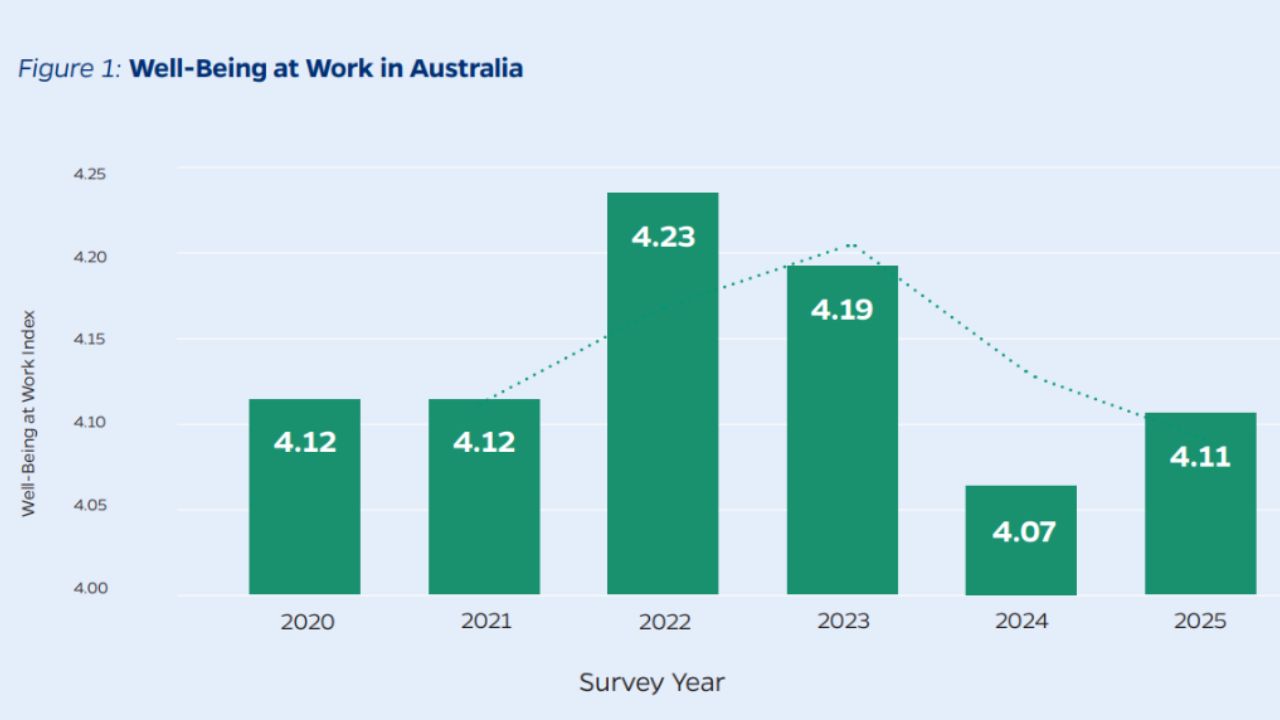
14 Nov Wellness at Work
Graph Source: Richard Smith and Rebecca Moulynox, Wellbeing at Work, creating a workplace where everyone can thrive, Australian Research Report, 2025
Addressing employee wellbeing makes commercial sense.
A simple, yet not that regularly acknowledge sentiment among businesses.
Why?
It is well documented that a positive workplace for wellbeing is a significant factor in employees being more engaged and productive. It is also linked to lower levels of depression, better mental and physical health, connectedness and financial security. And there is more: decreased distractions, increased job satisfaction and productivity.
Conversely there can be workplaces that do not enhance employee’s wellbeing. Poor mental and physical health. Erosion of business profits. Higher turnover of staff. Even these findings should be a motivator for action but alas this is not the case.
What can be done?
Trying to rectify poor wellbeing at work means the business must spend time creating the ideal employee climate. If this has not been done, then traction from employees will be lacking. Lack of embracement from employees translates into a poor return on investment on whatever is tried.
Aussie Study
A Longitudinal Australian Study, (over 6 years, 500 organisations, 80000 replies) indicated that wellbeing at work is back to where it was before the COVID-19 pandemic. During the pandemic, the Wellness at Work Index reached its peak.
The Wellbeing at Work Index is an index created from data collected in 5 million responses to questionnaires, across 30 countries.
The Index is scored 1-5 (higher the number the better) and focuses on
- Mental and Emotional Support
- Sense of purpose
- Personal support
- Financial health
- Meaningful connections
Environment is the key
Providing an environment at work that supports employee wellbeing is significantly more than just delivering a program. The environment must be linked to management practises, the culture of the business, how HR gets involved and business processes.
Many organisations are conscious of employee wellbeing and the associated benefits. The obstacle is that the action they take is from an unfavourable position. Not enough groundwork has been done.
Time to think differently.
The one size fits all approach to employee wellbeing, health and performance is limited. There are significant differences across any workforce. Gender, age, location and roles to name a few. Placing wellbeing at the heart of employee’s experiences while at work is a longer-term view. It takes and investment in the future of the business. If done well the employee will get involved with confidence and comfort.
The longitudinal study on Aussie’s Wellbeing at Work, suggests delivering initiatives to build trust, recognition and supportive relationships among employees should be the focus. Since COVID there has been a shift back to “normal” procedures. This is in spite of 80% of office workers reporting they are burnt out and employees psychological stress increasing.
Employee Wellbeing may only become a part of the fabric of business when it becomes a commercial imperative, and the focus shifts more to prevention.
Contact us if you wish to improve the wellbeing of your employees.
Source:
Richard Smith and Rebecca Moulynox, Wellbeing at Work, creating a workplace where everyone can thrive, Australian Research Report, 2025

